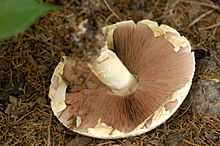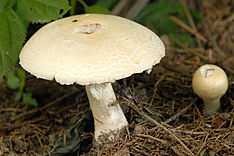Agaricus excellens
| ||||||||||||||||||||||||||||||||||||||||||||||||
Agaricus excellens (French: Psaliote Excellente, German: Riesen-Egerling[3]) is a rare mushroom in the genus Agaricus. It is native to Europe.
Description

A specimen of A. excellens.
- Cap: It is whitish yellow in color. Spread over 10–15 cm across, it is convex and a bit flat, yellowing slightly at the center especially with age, and densely covered in minute fibrous scales of the same colour. It feels silky.[1][4]
- Stem / Stipe: Stem is 100–140 x 20–35mm, white in color; the ring is thick and white. The underside is scaly or fibrillar.[1][4]
- Spores and microscopic features : Spore print is purplish black. Spores are elliptic, measuring 9–12 x 5–7µ.[1][4]
- Flesh and smell: The cap flesh is reddish-white. It tastes sweet and a bit like mushroom, smells slightly of aniseed and almond.[1][4]
Habitat
It is commonly found in coniferous and deciduous areas and grows during late autumn to summer amongst grass in open woodland, especially spruce. It is typically found at an altitude of 0 to 914 meters (0 to 2,999 feet).[3]
References
- ↑ 1.0 1.1 1.2 1.3 1.4 1.5 "Agaricus excellens". Rogers Mushrooms.
- ↑ "Agaricus excellens (F.H. Møller) F.H. Møller 1952". MycoBank. Retrieved 1 January 2000.
- ↑ 3.0 3.1 "Agaricus excellens". Zipcode Zoo.
- ↑ 4.0 4.1 4.2 4.3 4.4 "Agaricus excellens". MushLook.
